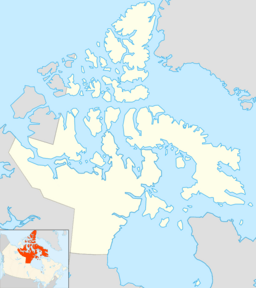Lancaster Sound facts for kids
Quick facts for kids Lancaster Sound |
|
|---|---|
| Tallurutiup Imanga | |
| Location | Qikiqtaaluk Region, Nunavut |
| Coordinates | 74°13′00″N 84°00′00″W / 74.21667°N 84.00000°W |
| Type | Strait |
| Native name | ᑕᓪᓗᕈᑎᐅᑉ ᐃᒪᖓ |
| Etymology | Named for James Lancaster |
| Part of | Parry Channel |
| Basin countries | Canada |
Lancaster Sound (called Tallurutiup Imanga by the Inuit people) is a large body of water in Nunavut, Canada. It is found between Devon Island and Baffin Island. This sound is like a gateway to the eastern part of the Parry Channel and the famous Northwest Passage. To its east is Baffin Bay, and to its west is Viscount Melville Sound. If you travel even further west, you would reach M'Clure Strait before entering the Arctic Ocean.
For thousands of years, the Inuit and their ancestors have lived near Lancaster Sound. They have always relied on its rich natural resources for food, clothes, and shelter. Today, people in the Nunavut communities of Pond Inlet, Arctic Bay, and Resolute still depend on these waters. The sound is important for their economy and their way of life.
Contents
History of Lancaster Sound Exploration
Lancaster Sound was named in 1616 by explorer William Baffin. He named it after Sir James Lancaster, who helped pay for his trips. In 1818, British explorer John Ross tried to explore the sound. He stopped because he thought mountains blocked the way.
However, in 1819, William Edward Parry sailed through the sound. He went as far west as Melville Island. The sound was fully mapped by the Canadian Government. This mapping was done from the 1930s to the late 1950s using planes. Interestingly, the planes used were Avro Lancaster bombers, changed for mapping.
Geography and Ice Cover
For about nine months each year, Lancaster Sound is covered in ice. This ice can be land-fast ice (stuck to the shore) or pack ice (floating ice). However, a special system called a "shore lead" creates areas of open water. This is important for animals that need to reach the surface to breathe.
Wildlife and Ecology
Lancaster Sound is home to many different kinds of animals. It has a huge amount of Arctic cod, which is a type of fish. These fish are a main food source for many birds and sea mammals in the area.
Many amazing animals live here, including narwhals, belugas, and bowhead whales. You can also find ringed, bearded, and harp seals, as well as walruses and polar bears. Many birds also visit, such as thick-billed murres, black-legged kittiwakes, northern fulmars, black guillemots, Arctic terns, ivory gulls, and snow geese.
Protecting Lancaster Sound
Early Efforts to Protect the Sound
In 1968, companies were given permission to look for oil and gas in the Arctic waters, including Lancaster Sound. In 1974, one company, Norlands Petroleum Ltd, wanted to drill an oil well there. But local communities were against it.
Because of this, a special group was formed to study the environmental impact. In 1978, this group said that drilling should not happen. They wanted the company to explain how drilling could be done safely without harming the sound.
People tried to make Lancaster Sound a National Marine Conservation Area in 1987. This was asked for by the local Inuit people. A study was done in 1989 to create a marine park, but nothing came of it at that time.
Tallurutiup Imanga National Marine Conservation Area
On December 8, 2009, the Canadian Environment Minister, Jim Prentice, announced a study to create a new National Marine Conservation Area (NMCA) in Lancaster Sound. An NMCA would stop oil and gas drilling in the area.
However, in 2010, a board approved plans for seismic testing in Lancaster Sound. This testing uses sound waves to look for oil under the sea. Many communities and groups spoke out against these tests. They were worried about the harm to marine animals.
In August 2010, a court in Nunavut agreed with the Inuit. The court stopped the seismic testing. It said there were risks to marine animals and the cultural heritage of the area. On December 6, 2010, the government announced it would set the boundaries for a new marine park in Lancaster Sound.
In 2012, the Qikiqtani Inuit Association (QIA) wrote a report about Lancaster Sound. It was called "Tallurutiup Tariunga Inulik," which means "Lancaster Sound has people" or "Lancaster Sound has Inuit." This report explained what an NMCA is and why the boundaries matter. It also shared the Inuit's views on protecting the ocean. The QIA sees Lancaster Sound as their homeland.
In June 2016, the park could grow even bigger. This happened when Shell gave up its oil leases in the area. Environmental groups had argued that these leases had expired.
In August 2017, the Canadian government, the Nunavut government, and the Qikiqtani Inuit Association reached an agreement. They set the final boundary for the protected area. It covers about 109,000 square kilometers (42,000 square miles). This makes it the largest marine conservation area in Canada.
The Tallurutiup Imanga is very important for its many seabirds and marine animals. These animals have supported the Inuit people for thousands of years. The United Nation's Convention on Biological Diversity mentioned this area in its 2020 report. Canada has created many protected marine areas, including the Tallurutiup Imanga, to help protect nature.
See also
 In Spanish: Estrecho de Lancaster para niños
In Spanish: Estrecho de Lancaster para niños


